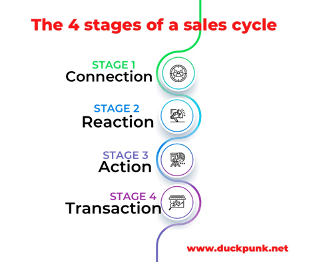Below Mellissa Tong, founder of NMSDC-certified DuckPunk Productions shares her four stages of a sales cycle.

I was a guest on a podcast recently, and the sales cycle topic came up. “How do you define a sales cycle and is there any way to shorten it?” I was asked. My answer was yes, absolutely, and it has to start with a compelling brand story that causes an emotional reaction. In my opinion, there are four stages in a sales cycle and the faster you can close one, the less time, money, and effort you will spend on client acquisition.
The first stage in the sales cycle is emotional connection. Without the emotional connection, there is no second stage. I have worked with many businesses on their elevator pitch, and unfortunately, this is not something most companies can get right. Too many of them talk about their business as a matter of fact (this is what we do). But the reality is no one cares. We recently worked with a SaaS company. They were good at articulating what they do very well. But they just ended their pitch there. There was no call to action, no special value proposition, no why them, nothing. The conversation was completely a one-way street, a dead-end.
As consumers, we are bombarded with so many ads, messages, emails, and texts, from every business out there possible. If you can’t connect in the first five to seven seconds with your potential customers, you’ve lost them.
During my podcast, the host asked me, “How do you create the emotional connection then? Do you decide what feeling you want to use first?” My answer was, “No, I don’t choose the feeling first. I work on the brand story first. To craft a compelling brand story, I pick out elements people will relate to, and use those elements to invoke an emotion from the audience. When your audience feels a certain way, it will lead them straight to stage two of the sales cycle, and that is a reaction.”
Think about it this way. If your pitch can cause your audience to react, it almost doesn’t matter what emotion they’re feeling, chances are, you can prompt them to act. Because the quicker they can decide if they want to buy from you or not, the quicker you can get to a transaction. If they choose not to buy from you, then at least you’re not spending any more time, money, and effort on courting them. You can move on to the next potential customer. That’s how you shorten your sales cycle. Let me give you some concrete examples here.
A heating and air-conditioning (HVAC) company that has been in business for over 75 years was focusing on selling units. Their pitch was always about whether their customer needed to install or service a new unit. It never occurred to them that the units were the tools they used to sell what they truly sold until they worked with us. Since then, they changed their pitch to what they truly sell: comfort. What do you think can invoke an emotional connection? Units or comfort? Units are tangible, comfort is intangible. Facts are tangible, and feelings are intangible. When they focus on comfort, there lies the emotional connection. When there is an emotional connection, there is a natural reaction. When there is a reaction, there comes action. And only action will lead to a transaction.
Here’s another example. We did a sales and storytelling training with Westin LAX. They had a long list of offerings for both their corporate clients and individual customers that included conference spaces, special events, weddings, product launches, wellness rooms, peloton rooms…the list goes on. Although each of these offerings might seem attractive to a particular clientele, by the time they’re down to the third offer on the list, they’ve already lost the attention of the customer. Since they switched that list to “customizable experiences” their customers were already there emotionally, ready to listen and take action.
A third example is a law firm that wants to switch focus from working exclusively with the government on land use and regulations to estate planning. The owner and her team couldn’t find any common thread and had a hard time articulating why anyone should even consider them for estate planning. After working together, their story became how the owner/principal is armed with over 20 years of legal experience, and being a second-generation Nigerian American and first-generation American Nigerian, she saw firsthand how estate planning is not just about the transfer of assets, but the transfer of knowledge and other intangible assets to preserve the cultural heritage. Again, intangible assets/cultural heritage creates the emotion that leads to reaction. With reaction, there comes action to result in a transaction.
If you understand these four stages are natural progressions, the only thing left to focus on is crafting your compelling brand story. If you can hit all the right notes with your brand story and succeed in the first stage, there is no way you will have trouble acquiring new customers!
Read more from Mellissa in her LinkedIn newsletter.



